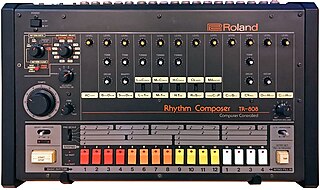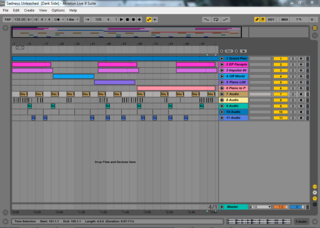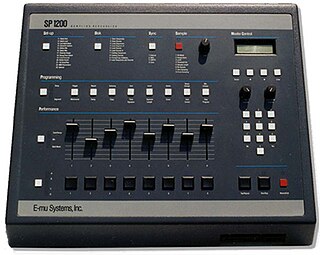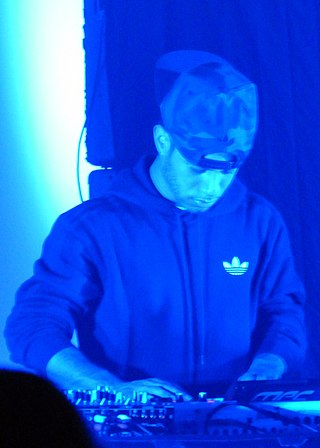
A drum machine is an electronic musical instrument that creates percussion sounds, drum beats, and patterns. Drum machines may imitate drum kits or other percussion instruments, or produce unique sounds, such as synthesized electronic tones. A drum machine often has pre-programmed beats and patterns for popular genres and styles, such as pop music, rock music, and dance music. Most modern drum machines made in the 2010s and 2020s also allow users to program their own rhythms and beats. Drum machines may create sounds using analog synthesis or play prerecorded samples.

Digital music technology encompasses digital instruments, computers, electronic effects units, software, or digital audio equipment by a performer, composer, sound engineer, DJ, or record producer to produce, perform or record music. The term refers to electronic devices, instruments, computer hardware, and software used in performance, playback, recording, composition, mixing, analysis, and editing of music.

The Roland TR-808 Rhythm Composer, commonly known as the 808, is a drum machine manufactured by Roland Corporation between 1980 and 1983. It was one of the first drum machines to allow users to program rhythms instead of using preset patterns. Unlike its nearest competitor at the time, the more expensive Linn LM-1, the 808 generates sounds using analog synthesis rather than by playing samples.

A groovebox is a self-contained electronic or digital musical instrument for the production of live, loop-based electronic music with a high degree of user control facilitating improvisation. The term "Groovebox" was originally used by Roland Corporation to refer to its MC-303, released in 1996. The term has since entered general use, and the concept dates back to the Movement Computer Systems Drum Computer in 1981.
Akai is a Hong Kong manufacturer of consumer electronics. It was founded as Akai Electric Company Ltd in Tokyo, Japan, in 1946.
A music workstation is an electronic musical instrument providing the facilities of:

A sampler is an electronic musical instrument that records and plays back samples. Samples may comprise elements such as rhythm, melody, speech, sound effects or longer portions of music.

Ableton Live, also known as Live or sometimes colloquially as "Ableton", is a digital audio workstation for macOS and Windows developed by the German company Ableton.

Roger Curtis Linn is an American designer of electronic musical instruments and equipment. He is the designer of the LM-1, the first drum machine to use samples, and the MPC sampler, which had a major influence on the development of hip hop. Roger Linn is also a member of the Dead Presidents Society, a group of innovators in the field of electronic music.

Hip hop production is the creation of hip hop music in a recording studio. While the term encompasses all aspects of hip hop music creation, including recording the rapping of an MC, a turntablist or DJ providing a beat, playing samples and "scratching" using record players and the creation of a rhythmic backing track, using a drum machine or sequencer, it is most commonly used to refer to recording the instrumental, non-lyrical and non-vocal aspects of hip hop.

The Boss Dr. Sample SP-303 is a discontinued digital sampler from Boss, successor of the Boss SP-202 Dr. Sample. The SP-303 was revamped and redesigned in 2005, and released as the SP-404, by Roland Corporation.

The E-mu SP-1200 is a sampler created by Dave Rossum that was released in August 1987 by E-mu Systems.

In sound and music, sampling is the reuse of a portion of a sound recording in another recording. Samples may comprise elements such as rhythm, melody, speech, or sound effects. A sample can be brief and only incorporate a single musical note, or it can consist of longer portions of music, and may be layered, equalized, sped up or slowed down, repitched, looped, or otherwise manipulated. They are usually integrated using electronic music instruments (samplers) or software such as digital audio workstations.

Controllerism is the art and practice of using musical software controllers, e.g. MIDI, Open Sound Control (OSC), joystick, etc., to build upon, mix, scratch, remix, effect, modify, or otherwise create music, usually by a Digital DJ or Live PA performer, often called a controllerist. Controllerism is also a nod to traditional musicianship and instrumental-ism paired with modern computer sequencing software such as Ableton Live and Native Instruments Traktor. However a working knowledge of scales and chords is not necessarily required as the performers typically focus their efforts more on sequencing events, software effect and instrument manipulations using buttons, knobs, faders, keys, foot switches and pedals than on instrumental notes played in real time. With recent developments in music technology, particularly in software instruments, a USB MIDI controller enables musicians almost unlimited possibilities to control a wide variety of sound types.

Abraham Orellana, better known as his stage name AraabMuzik, is an American record producer and DJ. He made a name for himself by performing beats and instrumentals live and in real time on a AkaiPro Music Production Center (MPC) drum machine. He uses MPC to produce rapid, rhythmic drum patterns and creates melodies with samples and other sounds.
Boom bap is a subgenre and music production style that was prominent in East Coast hip hop during the golden age of hip hop from the late 1980s to the early 1990s.

The Linn 9000 is an electronic musical instrument manufactured by Linn Electronics as the successor to the LinnDrum. It was introduced in 1984 at a list price of $5,000, and about 1100 units were produced.
Bruce Forat is an electronics engineer, computer programmer, music producer, songwriter and co-founder and president of Forat Music and Electronics Corporation, founded in 1986.

The Forat F9000 is a software- and hardware-upgraded version of the ill-fated Linn 9000, an integrated digital sampling drum machine and hardware MIDI sequencer manufactured by Linn Electronics and released in 1984 at a list price of $5,000.

The LinnDrum Midistudio was going to be an electronic musical instrument produced by Linn Electronics as the successor to the ill-fated Linn 9000, which was an integrated digital sampling drum machine and MIDI sequencer. The Midistudio is essentially a rack-mount version of the Linn 9000 with some improvements. It was revealed at the 1986 Winter NAMM Show in January for a list price of $5,990. However, it never went into production because Linn Electronics went out of business in February 1986.




















